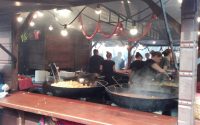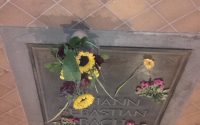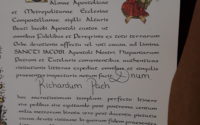Camino Ingles: Following A Different Path – Part 1
This section has nothing whatsoever to do with ancestry or family history but as the theme of identity crops up in entire blog, I should include it.
25.04.2019
Almost a year ago, an ex-colleague, Greg Wilson, stopped me in the street as I made my way to catch a train, and asked if I might be interested in walking the Camino Ingles in Spain. I had heard of various pilgrimages to Santiago de Compostela, including this one and all have been widely covered in books, film and TV documentary and I suppose I might never have thought about walking any of them unless someone asked. Then came this opportunity. We have been training together and separately and prepared as well as we can. The third member of the trio is Gavin Lapworth, both he and Greg are ex-army, the best I can do is the Senior Scouts.
For the last four years all my trips away have had a connection in some way to my paternal family history, including the trip to Israel, the latter more to do with learning Ashkenazi Jewish people’s own experience in central Europe.
In Spain I do not expect to find anything relating to my family but, you never know! Our Camino walk has no religious or spiritual significance, nor is it ‘finding yourself’. It’s because it’s there and for me, I’m keen to follow the experience of the countless millions before us.
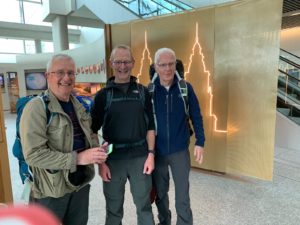
The taxi I booked to take us from Santiago de Compostela Airport to our starting point, Ferrol did not arrive. The person on the other end of the line spoke little or no English and my knowledge of Spanish is a fraction above zero. An agent on the tourist information desk was very helpful and contacted the taxi firm on our behalf. You don’t really need to speak the language to identify a problem, you can tell by intonation and facial expressions that something is not quite right and in our case this is so. It appears that there has been a dispute between the booking agent and the local taxi firm and we are caught in the resulting crossfire. We simply ordered another taxi and en route I phoned my bank and had the payment put on dispute to resolve further when I get home. And so on to Ferrol, which, at 70,000 inhabitants, turns out to be larger than any of the three of us imagined. The centre is pleasantly laid out, clean, and has history; being as it was the disembarkation point for pilgrims, particularly from England and Ireland. Checked in at our hotel, we decide to walk from the starting point where we can get a sello, that is a stamp in our Pilgrim’s Passport, to a roundabout where we will connect with the Camino in the morning. This counts. The start point, rather conveniently is a bar and three Estrellas, are accompanied by small bowls of lentil soup, then sausage and finally cake, all included in the €6 we are charged. This is the land of the tapas accompaniment! We are on our way!

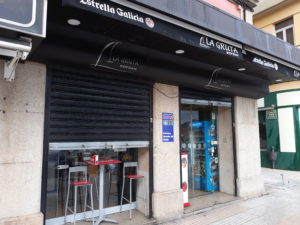

26.04.2019
Day 1 proper and we are walking to Neda a distance of 20km from our starting point yesterday, but as we already covered 3km yesterday, we will walk 17km today. We agree to breakfast after about 45-60 minutes walking. It’s drizzling, but again this is the Atlantic side of Spain. Breakfast costs €3 and for that there is a choice of coffee and anything you can eat from a buffet table, in other words an ideal way get fuelled up for the rest of the day’s trek on finger buffet items, Spanish omelette and very large croissants.
The Camino route is well marked and so far we have made no wrong turns. The Camino sign, which is the shape of a shell can be seen on the sides of buildings and just about anywhere. The route follows the estuary south and is mainly flat but with a few unanticipated ascents which demand answers of your stamina. Thank goodness the rucksack only weighs around 5kg. Since the time of the first pilgrims the area has been developed, obviously, with houses and industry and, in the present day car showrooms, but the original route seems to remain true. We had expected the route would take us through small towns, so the going varies from earth to tarmac and concrete. The locals always have a ‘buen camino’ greeting as they pass us and we reply ‘gracias’ which is always appreciated. We have also added the infinitely useful word ‘cerveza’ to our extremely limited vocabulary. The distances to Santiago de Compostela on Camino signs display odd numbers and I wonder if it’s because, being the English route, the distances were originally in miles before the introduction to metric after the French Revolution. The first pilgrims we encounter are from Milan who tell us this is their second Camino, having already walked the Portuguese one which is 225km approximately.
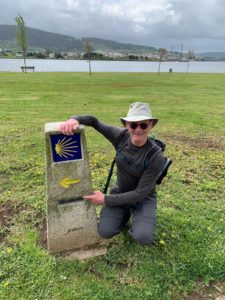
We arrive at our first stop, Neda, around lunchtime. We had originally intended to make it to the next stop, Pontedeume, in one day but it was right to break ourselves in. First there and checking in at the albergue completed, having had the choice of bunks, it’s a welcome beer(s) and tapas.
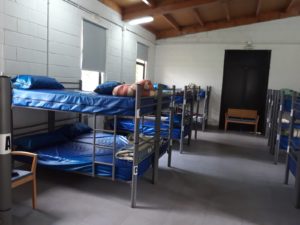
The albergue, which is basic but very clean provides a paper fleece pillow slip and sheet. Showers, washrooms and a cooking area are clean too, Neda is in an attractive setting but very quiet, with few bars. We have already met Italians, Swedes, Spaniards, Czechs, Puerto Ricans and Argentinians and the atmosphere is very sociable.
27.04.2019
Snoring is the same in any language and that’s just what’s been experienced. I wish I’d recorded it for YouTube. We set off early on a drizzly morning and our first stop will be somewhere for breakfast. One hour later we find a place in a small town called Fene and here we can have our Camino passport stamped. Basic breakfast but amazing coffee. We are joined unexpectedly by three other pilgrims who also stayed in the albergue in Neda; one Czech and two Italians. Leaving Fene we head into proper countryside on a narrow path sometimes on steep ascents, past farmhouses each it would seem with a barking German shepherd dog or two, and on through wooded areas. The waymarkers are still consistent and around 11.30 we arrive on the outskirts of our next stopover – Pontedeume. A long bridge crosses over the River Eume and into the town and it’s pleasant surprise. This looks to be a neat town crammed with history, it being a monastery town. Lots to explore up the narrow alley ways and numerous places for refreshment of which we, of course, take advantage. By now the site of fellow pilgrims is a common one and we are reunited with the Swedes we met yesterday at the tourist information office which is housed in an old ‘keep’ called Torreon dos Andrade. The display on the upper floors depicts the town’s medieval importance, strategically, economically and religiously. Tomorrow we will be almost immediately on a long steady ascent to our next destination. Food and a few Estrellas will blot that out for now.
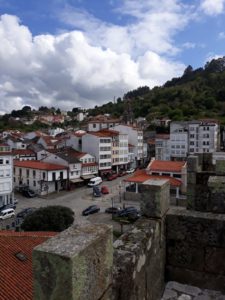
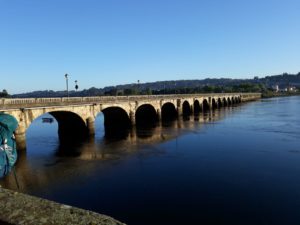
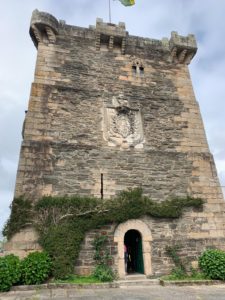
28.04.2019
Breakfast of two croissants and coffee is sufficient to begin the day’s walking and other pilgrims are in the same café. We do not team up otherwise the group becomes top heavy. ‘Buen camino’ and ‘see you in Betanzos (the next stop) is enough. And then we remember the 2km or so ascent we have to do and which we defer for half an hour by taking photographs posing in front of the bridge over the river as it is a beautiful sunny morning. Higher and higher, warmer and warmer the ascent seems more than the 2km we had anticipated and then into a wooded area where we meet fellow walkers and the Czech girl who is meditating in a yoga position facing the sun. We walk past without disturbing her. Why on earth should we? Arriving at a small town, or better a large village, called Minas I suddenly get the notion for churros and a local resident guides us after Greg asked the way, finally dispensing with his phrasebook Spanish and avoiding the ‘do you speak English’ in a very loud voice. His Spanish is well improvised as we sit down to churros and coffee in the sun. Onwards along the banks of the river, the waymarkers still generously spaced out, a few steep ascents in the hilly wooded landscape, passing old churches with graves build above ground. I’m guessing the land is too precious for vegetable gardening to be wasted on cemeteries. A descent into Betanzos probably the largest town in the immediate area. It’s Sunday and the cafés are bustling but out of the sun we find a spot for a welcome Estella.

We must have looked lost as we try to find the albergue, when a woman runs out of a churreria shouting ‘Señor Vilson’ and we follow her through a warren of locked doors for which we have to remember which key goes where. That certainly saved us a bit of sightseeing and beer time.
Betanzos is an attractive town in the sunshine with a large open area surrounded, as I said with numerous café/restaurants. After a meal and a couple more Estrellas we explore Betanzos by night and arrive at a bar and a table around which sit four Italian walkers/pilgrims whom we had previously met in Pontedeume. They had walked directly from Ferrol to Pontedeume without a break and had found it quite strenuous as a first leg. Thank goodness we had decided to break that part. A few local liqueurs as we ponder tomorrows section to Mesón do Vento which is the longest section of the Camino.

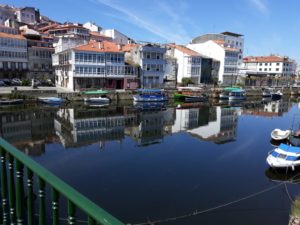

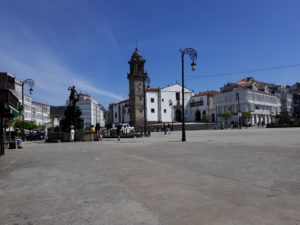
Ends
